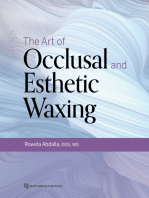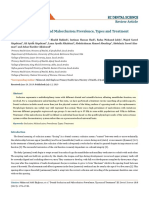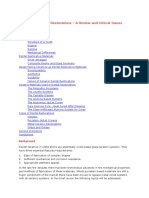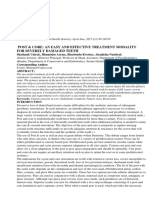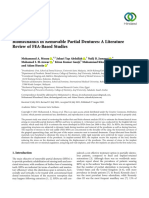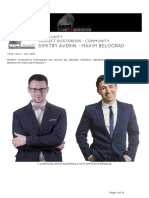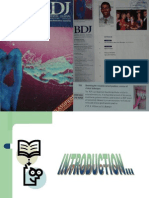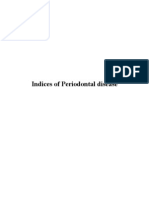Application of The Rotational Path Design Concept To A Removable Partial Denture With A Distal-Extension Base
Application of The Rotational Path Design Concept To A Removable Partial Denture With A Distal-Extension Base
Uploaded by
Chepe LemusCopyright:
Available Formats
Application of The Rotational Path Design Concept To A Removable Partial Denture With A Distal-Extension Base
Application of The Rotational Path Design Concept To A Removable Partial Denture With A Distal-Extension Base
Uploaded by
Chepe LemusOriginal Title
Copyright
Available Formats
Share this document
Did you find this document useful?
Is this content inappropriate?
Copyright:
Available Formats
Application of The Rotational Path Design Concept To A Removable Partial Denture With A Distal-Extension Base
Application of The Rotational Path Design Concept To A Removable Partial Denture With A Distal-Extension Base
Uploaded by
Chepe LemusCopyright:
Available Formats
Application of the rotational path design concept to a
removable partial denture with a distal-extension base
Marshall L . Asher , DDP
Fort Benning, Ga.
Biomechanical considerations for use of the rotational path design concept to
construct a remova.ble partial denture for a patient with a tooth-bounded ridge on
one side and a distal-extension ridge on the opposite side are presented. The
various axes and arcs of rotation that occur during masticatory function are
identified and their effects on the prosthesis and supporting structures are ana-
lyzed. Sequential steps in the necessary surveys of the master cast are enumer-
ated. Critical details for the most effective and least deleterious placement of the
rigid retentive element on the mesial surface of the posterior molar abutment (on
the tooth-bounded ridge) are described. (J PROSTHET DENT 1992;68:641-3.)
T he concepts of “dual path” and “rotational path” a rest seat that will allow unimpeded rotation. Care must
removable partial dentures were published in the late be taken to ensure that this rest seat preparation is not un-
1970s.rS3These approaches to removable partial denture dercut with respect to the initial path of placement. As with
design used precisely fitting minor connectors to engagethe certain rotational path designs, the master cast is surveyed
infrabulges of abutment proximal surfaces and thereby and tripodized at both the initial path of placement and at
provide retention without a conventional retentive clasp the final (fully seated) path of placement. The exact area
arm. These concepts resulted in improved esthetics and to be engaged by the rotational path retentive element
stability. In the ensuing years, inadequate understanding must then be determined and marked by use of the follow-
of the mechanics of rotational path removable partial den- ing step-by-step procedure:
ture design sometimes produced removable partial den- 1. Place the master cast on the surveyor so that the occlusal
tures that were actually detrimental to the health of the plane is perpendicular to the surveying rod.
dentition. In response, a number of articles that provided 2. On the master cast, place a straight edge along the axis
definitive guidelines to avoid potential errors in design of rotation and use the surveyor to draw a vertical line
were published.4-8 from the axis of rotation down the mesiolingual cusp of
It is widely recognized that in a rotational path design, the molar (Fig. 2, line E).
there is a potential for unfavorable mechanical leverage 3. Place a straight edge against the mesiolingual cusp par-
when a rigid retentive component is used in a distal-exten- allel to the plane of occlusion and at right angles to the
sion base situation. However, there is an undercut area on axis of rotation (Fig. 1, line C). Mark the point at which
the molar abutment of a mandibular Kennedy class II the straight edge contacts the tooth. Draw a vertical line
(modification 1) removable partial denture that may be through this tangent point on the mesiolingual cusp
used for rotational path retention. The following design is (Fig. 2, line F).
presented for consideration. The survey line that marks the height of contour of the
molar abutment at the final path of placement is the coro-
DESIGN nal limit of the retentive area (Fig. 2, line D). The area that
Occlusal rest seats are prepared mesially on the terminal can be contacted by the rotational path retentive element
abutment on the distal-extension side, distally on the an- has now been demarcated (Fig. 2, area C). The framework
terior abutment on the tooth-supported side, and mesially should be cast to contact this entire area without any re-
on the molar abutment (Fig. 1). The rest seat on the molar lief. The clasp assembly for the molar is completed by add-
should be as long as possible, and oriented exactly along the ing a bracing arm that extends around the buccal surface,
planned axis of rotation for the framework (Fig. 1, line B). with its gingival edge on the survey line and its tip termi-
The floor of the preparation must be rounded to produce nating precisely on the axis or rotation. A clasp assembly
that avoids lateral stress during rotational movement is
placed on the terminal abutment on the tissue-supported
side.
The opinions or assertions contained herein are the private views The positive retention provided by the rotational path
of the author and are not to be construed as official or as reflect-
retentive element makes clasp placement unnecessary on
ing the views of the Department of the Army.
aLieutenant Colonel, U.S. Army, DC; Assistant Director, Ad- the anterior abutment of the tooth-supported segment.
vanced Education in General Dentistry. This tooth need only provide vertical support and indirect
10/1l39926 retention through a properly designed rest.
THE JOURNAL OF PROSTHETIC DENTISTRY 641
ASHER
Fig. 2. View of the molar abutment as seen from the
mesiolingual surface. A, Bracing arm; B, occlusal rest; C,
Fig. 1. Design features. A, Rotational path retentive ele- area contacted by the rotational path retentive feature; D,
ment; B, axis of rotation; C, line perpendicular to B and height of contour; E, vertical line through the axis of rota-
tangent to the tooth; D, bracing arm. tion; F, vertical line through the tangent point.
Clinical use of this design over many years has not caused
When a distal-extension base is loaded in function, the failure due to molar drifting. Perhaps this fortuitous lack
removable partial denture tends to rotate. The rotational of failure is because of the presence of the rotational path
movement of any part of the prothesis anterior to the axis rigid retentive element in the mesiolingual undercut. The
of rotation may have some movement occlusally. It is for casting contact actually provides passive resistance to the
this reason that the framework must not contact the tendency of the lower molar to drift in a mesiolingual di-
infrabulge area anterior to the vertical line drawn through rection in response to occlusal forces.
the axis of rotation (Fig. 2, line E). All portions of the This design is most applicable when the modification
prosthesis distal to the axis of rotation will move in a me- space requires the replacement of at least one premolar and
siogingival arc. Should the framework contact the tooth one molar. It allows adequate space for the rotational path
distal to the tangent point (Fig. 2, line F), this rotational of placement without excessive blockout on the anterior
movement would impinge on the tooth and cause me- abutment.
siobuccal torque. Between these two lines (Fig. 2, area C), Although the framework design allows rotational move-
the mesiogingival rotational movement would result in a ment to occur without torque on the abutment teeth, an
very slight disengagement of the framework. Therefore, altered cast impression technique is recommended for the
during function there are minimal forces applied to the distal-extension base to ensure optimum tissue support
tooth by a rotational path retentive element that is limited and stability of the prosthesis. Its objective is to reduce ro-
to this area. The buccal bracing arm is not designed to pro- tational movement when masticatory forces are applied to
vide reciprocation, but simply to prevent horizontal move- the distal extension base.
ment of the framework, thereby ensuring that the rota-
tional path retentive element remains in contact with the CONCLUSION
tooth when the prosthesis is not in function. When the di- By including a rotational path rigid retentive element in
stal-extension base is depressed in function, the buccal arm a design that accommodates rotational movement in func-
will rotate occlusally and disengage. However, the extreme tion, exceptional stability is achieved with minimal stress
tip will show no perceptible movement because it is placed to the abutments. In addition, the total absence of lingual
precisely on the axis of rotation retentive or bracing clasp arms renders the prosthesis more
It is apparent that a long channel-type rest seat, guiding hygienic and comfortable for the patient. The primary dis-
plane, SO-degree encirclement, or any feature recom- advantage is the need for direct communication with
mended to prevent drifting of the molar abutment has not knowledgeable laboratory personnel. For best results, each
been included in this design. Because of the rotation that prosthesis should be discussed with the technicians who
will occur in function, each of these design items would will construct the framework. This may become less neces-
cause torque on the tooth and therefore should not be used. sary once the technicians become familiar with the concept.
642 OCTOBER 1992 VOLUME 68 NUMBER 4
RPD WITH DISTAL-EXTENSION BASE
REFERENCES
6. Firtell DN, Jacobsen TE. Removable partial dentures with rotational
1. King GE. Dual path design for removable partial dentures. J PROSTHET paths of insertion: problem analysis J PROSTHET DENT 1983;50:8.
DENT 1978;39:392. 7. Daniel RE, Granata JS. The rotational path removable partial denture.
2. King GE, Barco MT, Alson RJ. Inconspicuous retention for removable Compend Contin Educ Dent 1985;6:716.
partial dentures. J PROSTHET DENT 19’78;39:505. 8. Bauman R. Rotational path partial dentures: problems and potential.
3. Garver DG. A new clasping system for unilateral distal-extention Compend Contin Educ Dent 1986;7:356.
removable partial dentures. J PROSTHET DENT 1978;39:268.
4. Jacobson TE, and Krol AJ. Rotational path removable partial denture Reprint requests to:
design. J PROSTHET DENT 1982;48:370. DR. MARSHALL L. ASHER
5. Jacobsen TE. Satisfying esthetic demands with rotational path partial 508 WICKER~HAM AVE.
dentures. J Am Dent Assoc 1982;105:460. FORT BENNING, GA 31905
Bound volumes available to subscribers
Bound volumes of THE JOURNAL OF PROSTHETIC DENTISTRY are available to subscribers
(only) for the 1992 issues from the publisher at a cost of $55.00 ($68.00 international) for
Vol. 67 (January-June) and Vol. 68 (July-December). Shipping charges are included. Each
bound volume contains a subject and author index, and all advertising is removed. Copies
are shipped within 30 days after publication of the last issue in the volume. The binding
is durable buckram with the journal name, volume number, and year stamped in gold on
the spine. Volumes 65 and 66 are also available. Payment must accompany all orders.
Contact Mosby-Year Book, Inc., Subscription Services, 11830 Westline Industrial Drive,
St. Louis, MO 63146-3318, USA; phone (800) 3254177, ext. 4351, or (314)453-4351.
Subscriptions must be in force to qualify. Bound volumes are not available
in place of a regular JOURNAL subscription.
THE JOURNAL OF PROSTHETIC DENTISTRY 643
You might also like
- Dental Anatomical Combinations:A Guide To Ultimate Dental Esthetics - Giuseppe RomeoDocument30 pagesDental Anatomical Combinations:A Guide To Ultimate Dental Esthetics - Giuseppe RomeoLoke WeiqiangNo ratings yet
- Free DTRBN Professional Exam Past QuestionsDocument5 pagesFree DTRBN Professional Exam Past QuestionsCharles Obaleagbon80% (5)
- Introduction of A Novel Anatomic Recession RatioDocument11 pagesIntroduction of A Novel Anatomic Recession Ratiojuanita enriquezNo ratings yet
- History of Orthodontics (1) EnviarDocument49 pagesHistory of Orthodontics (1) Enviarmateo bravoNo ratings yet
- Minimally Invasive Periodontal Therapy: Clinical Techniques and Visualization TechnologyFrom EverandMinimally Invasive Periodontal Therapy: Clinical Techniques and Visualization TechnologyNo ratings yet
- Orthodontically Driven Corticotomy: Tissue Engineering to Enhance Orthodontic and Multidisciplinary TreatmentFrom EverandOrthodontically Driven Corticotomy: Tissue Engineering to Enhance Orthodontic and Multidisciplinary TreatmentFederico BrugnamiNo ratings yet
- The Bennett Angle: Clinical Comparison of Different Recording MethodsDocument6 pagesThe Bennett Angle: Clinical Comparison of Different Recording MethodsFrank Bermeo100% (1)
- WHT Is A VeneerDocument3 pagesWHT Is A VeneeruhvyasNo ratings yet
- Dental Wax UpDocument4 pagesDental Wax UpJoselyn RodriguezNo ratings yet
- Survival of Porcelain Laminate Veneers With DifferentDocument10 pagesSurvival of Porcelain Laminate Veneers With DifferentPablo BenitezNo ratings yet
- Oral Rehabilitation With Removable Partial Dentures in Advanced Tooth Loss SituationsDocument7 pagesOral Rehabilitation With Removable Partial Dentures in Advanced Tooth Loss SituationsIoana-NicoletaNicodimNo ratings yet
- Clinical Evaluation of Abutment Teeth of Removable PartialDocument7 pagesClinical Evaluation of Abutment Teeth of Removable PartialAlex KwokNo ratings yet
- Biomechanics of Post Core SystemDocument18 pagesBiomechanics of Post Core SystemNourhan IbrahimNo ratings yet
- Removable Partial Dentures: The Clinical Need For InnovationDocument8 pagesRemovable Partial Dentures: The Clinical Need For InnovationNetra TaleleNo ratings yet
- Digitalization in Dentistry CADCAM A ReviewDocument6 pagesDigitalization in Dentistry CADCAM A ReviewnabeghNo ratings yet
- RPD BasicsDocument63 pagesRPD BasicsMahmud J. BarznjiNo ratings yet
- Dental Ceramics For Restoration and Metal VeneeringDocument23 pagesDental Ceramics For Restoration and Metal VeneeringMichael XuNo ratings yet
- Dental Cements For Definitive LutingDocument16 pagesDental Cements For Definitive LutingParmod GuliaNo ratings yet
- Procedural Dentistry For Complete DenturesDocument272 pagesProcedural Dentistry For Complete DenturesNatalia GuevaraNo ratings yet
- All Ceramic (Part 1)Document41 pagesAll Ceramic (Part 1)Faisal Ali BalochNo ratings yet
- Alginate Impression MaterialDocument92 pagesAlginate Impression MaterialrusschallengerNo ratings yet
- RO0111 00-00 WebberDocument6 pagesRO0111 00-00 WebberARTNo ratings yet
- JURNAL - Dental Occlusion and Malocclusion Prevalence, Types and TreatmentDocument8 pagesJURNAL - Dental Occlusion and Malocclusion Prevalence, Types and TreatmentAndrew SipayungNo ratings yet
- Aesthetic Clasp Design For Removable Partial Dentures A Litewrature ReviewDocument5 pagesAesthetic Clasp Design For Removable Partial Dentures A Litewrature Reviewpablogdv956100% (1)
- Titanium Framework Removable Partial Denture Used ForDocument4 pagesTitanium Framework Removable Partial Denture Used ForManjeev GuragainNo ratings yet
- Ceramics in Dental RestorationsDocument11 pagesCeramics in Dental RestorationsDaniel CostinNo ratings yet
- Fracture Resistance and Marginal Discrepancy of Porcelain Laminate Veneers Influenced by Preparation Design and Restorative Material in Vitro PDFDocument8 pagesFracture Resistance and Marginal Discrepancy of Porcelain Laminate Veneers Influenced by Preparation Design and Restorative Material in Vitro PDFLuis Alberto Carpio MorenoNo ratings yet
- Evolution Removable Partial Denture Design: Academics and EducationDocument9 pagesEvolution Removable Partial Denture Design: Academics and EducationSahana RangarajanNo ratings yet
- Hera CeramDocument60 pagesHera CeramStefan IonelNo ratings yet
- I015322838 PDFDocument11 pagesI015322838 PDFhinanaimNo ratings yet
- Effect of Removable Partial Denture On Periodontal HealthDocument3 pagesEffect of Removable Partial Denture On Periodontal HealthAlex KwokNo ratings yet
- Inlay - Clinical AspectsDocument37 pagesInlay - Clinical AspectsDr Dithy kkNo ratings yet
- Atraumatic Restorative Treatment: Restorative ComponentDocument11 pagesAtraumatic Restorative Treatment: Restorative ComponentYu Yu Victor Chien100% (1)
- Modellherstellungsfibel en PDFDocument45 pagesModellherstellungsfibel en PDFcontinentdriftNo ratings yet
- Occlusal CorrectionDocument5 pagesOcclusal CorrectionTejas KhaireNo ratings yet
- Post and Cores CaseDocument7 pagesPost and Cores Caseanuj sharmaNo ratings yet
- How Dentogenic Restorations Interpret The Sex FactorDocument13 pagesHow Dentogenic Restorations Interpret The Sex FactorblokolbNo ratings yet
- RPD DesigenDocument112 pagesRPD DesigenMohamedNo ratings yet
- Goodacre 2004 - Designing Tooth Preparations For Optimal SuccessDocument27 pagesGoodacre 2004 - Designing Tooth Preparations For Optimal Successcobby174No ratings yet
- Longevity of Ceramic Veneers in General Dental PracticeDocument5 pagesLongevity of Ceramic Veneers in General Dental PracticeAhmadModiNo ratings yet
- Scientific and Artistic Tooth Shade SelectionDocument6 pagesScientific and Artistic Tooth Shade SelectionVero AngelNo ratings yet
- Selection and Arrangement of Teeth For Complete Dentures: By: Dr. Rohan BhoilDocument84 pagesSelection and Arrangement of Teeth For Complete Dentures: By: Dr. Rohan BhoilMaqbul AlamNo ratings yet
- Protaper Gold Treatment: Directions For UseDocument7 pagesProtaper Gold Treatment: Directions For UseFarisah AtsariNo ratings yet
- Guide To All-Ceramic BondingDocument12 pagesGuide To All-Ceramic BondingDan CosteaNo ratings yet
- BioMed Research International - 2021 - Mousa - Biomechanics in Removable Partial Dentures A Literature Review of FEA BasedDocument16 pagesBioMed Research International - 2021 - Mousa - Biomechanics in Removable Partial Dentures A Literature Review of FEA BasedFreddy BenalcázarNo ratings yet
- Art-11-Mageet Malocclusion ClassifictnDocument7 pagesArt-11-Mageet Malocclusion ClassifictnDharampal SinghNo ratings yet
- Cad CamDocument5 pagesCad CamsauriuaNo ratings yet
- Interventions For Missing Teeth: Removable Prostheses For The Edentulous Mandible (Protocol)Document11 pagesInterventions For Missing Teeth: Removable Prostheses For The Edentulous Mandible (Protocol)rahmaNo ratings yet
- Tests Orthodontics Ex - An.v en 2018-2019 in Lucru LazarevDocument31 pagesTests Orthodontics Ex - An.v en 2018-2019 in Lucru LazarevAndrei Usaci100% (1)
- Space LossDocument5 pagesSpace LossAsma NawazNo ratings yet
- ZirconiaDocument8 pagesZirconiaAmitNo ratings yet
- Community Dimitry Averin Maxim Belograd ViaDocument14 pagesCommunity Dimitry Averin Maxim Belograd ViaCarlos Nieto MallquiNo ratings yet
- 04 - 003 Dental Luting CementsDocument2 pages04 - 003 Dental Luting CementsZazilatul KhikmiahNo ratings yet
- Cobalt-Chromium Alloys in Dentistry An Evaluation of Metal Ion ReleaseDocument7 pagesCobalt-Chromium Alloys in Dentistry An Evaluation of Metal Ion ReleaseFrank LucariniNo ratings yet
- Mandibular Second Premolar: Prof. A. El-SahnDocument68 pagesMandibular Second Premolar: Prof. A. El-SahnRekha PtsNo ratings yet
- 18.recording The RCP-A Review of Clinical TechniquesDocument152 pages18.recording The RCP-A Review of Clinical TechniquesHemalatha Lakshminarayan100% (1)
- Dentsply Tooth Arrangement ManualDocument41 pagesDentsply Tooth Arrangement Manualpopat78100% (3)
- 1proteza Partiala Mobilizabila, Nevoia Clinica de Inovare 2017 Journal of Prosthetic DentistryDocument8 pages1proteza Partiala Mobilizabila, Nevoia Clinica de Inovare 2017 Journal of Prosthetic DentistrydanielaNo ratings yet
- Telescopic DentureDocument5 pagesTelescopic DentureDrRahul Puri GoswamiNo ratings yet
- Porcelain Fused To Metal CrownsDocument5 pagesPorcelain Fused To Metal CrownsCitra Dwi PrastiwieNo ratings yet
- Implant-Tissue Supported, Magnet-Retained Mandibular Overdenture For An Edentulous Patient With Parkinson's Disease - A Clinical ReportDocument4 pagesImplant-Tissue Supported, Magnet-Retained Mandibular Overdenture For An Edentulous Patient With Parkinson's Disease - A Clinical ReportChepe LemusNo ratings yet
- May 2009 - Predictable Margin Placement For Long Term EsthDocument11 pagesMay 2009 - Predictable Margin Placement For Long Term Esthawagh012No ratings yet
- 32 High-Impact Marketing Tips For ProsthodontistsDocument5 pages32 High-Impact Marketing Tips For ProsthodontistsChepe LemusNo ratings yet
- 07009c 003 013 000 DeproteinizationDocument8 pages07009c 003 013 000 DeproteinizationChepe LemusNo ratings yet
- A Loading Impression Technique For Semi Precision and Precision Removable Partial DenturesDocument6 pagesA Loading Impression Technique For Semi Precision and Precision Removable Partial DenturesChepe LemusNo ratings yet
- The Gliding Path of The Mandible Along The Skull: Special ContributionDocument6 pagesThe Gliding Path of The Mandible Along The Skull: Special ContributionMario CastellanosNo ratings yet
- Department of OprativeDocument38 pagesDepartment of OprativeDevilish EggsNo ratings yet
- Aesthetics Brought Back To Essentials: EssentiaDocument12 pagesAesthetics Brought Back To Essentials: EssentiaAyaskaSummersNo ratings yet
- Sliding Frictional MechanicsDocument81 pagesSliding Frictional MechanicsesmaelNo ratings yet
- 00 Power ChainsDocument7 pages00 Power Chainsplazari07No ratings yet
- Surgical GuideDocument29 pagesSurgical GuideVăn Trọng MinhNo ratings yet
- Risks and Complications of Orthodontic MiniscrewsDocument51 pagesRisks and Complications of Orthodontic MiniscrewsutokaNo ratings yet
- Team Atlanta - Prosthetic Gingival Reconstruction in The Fixed Partial RestorationDocument4 pagesTeam Atlanta - Prosthetic Gingival Reconstruction in The Fixed Partial Restorationcolt_albNo ratings yet
- Elastics Usage Brochure NDocument16 pagesElastics Usage Brochure Npaola brito100% (1)
- Royal London Space AnalysisDocument47 pagesRoyal London Space AnalysisYusra ShaukatNo ratings yet
- Snap Guardian Dental Plan Summary 2022Document4 pagesSnap Guardian Dental Plan Summary 2022Samson FungNo ratings yet
- Prevalence of Overhang Interproximal Amalgam RestorationsDocument4 pagesPrevalence of Overhang Interproximal Amalgam RestorationsNaji Z. ArandiNo ratings yet
- Principles of Cavity Preparation: DR - HussainDocument7 pagesPrinciples of Cavity Preparation: DR - HussainruchikaNo ratings yet
- Conferinta StomDocument4 pagesConferinta StomalexNo ratings yet
- ATHLETES CredentialsDocument14 pagesATHLETES CredentialsJerahmae NavarraNo ratings yet
- Factores Macroesteticos en El Diseño de SonrisaDocument7 pagesFactores Macroesteticos en El Diseño de SonrisaJassel DurdenNo ratings yet
- Disjunção Palatina - Técnica de GlassmanDocument4 pagesDisjunção Palatina - Técnica de Glassmangeorge_boraksNo ratings yet
- Smile ArcDocument14 pagesSmile ArcPratNo ratings yet
- Oral Histology - NEET MDSDocument6 pagesOral Histology - NEET MDSdrpnnreddyNo ratings yet
- Relationship Between Dental Size and Normal Occlusion in Brazilian PatientsDocument5 pagesRelationship Between Dental Size and Normal Occlusion in Brazilian PatientsCristian OneaNo ratings yet
- Permanent Mandibular Lateral IncisorsDocument2 pagesPermanent Mandibular Lateral IncisorsSafura IjazNo ratings yet
- CAD CAM - Annalsandessences 1Document7 pagesCAD CAM - Annalsandessences 1Aswathi RaghuthamanNo ratings yet
- Straumann Pro Arch DR EskanDocument3 pagesStraumann Pro Arch DR EskanShyam BhatNo ratings yet
- Interdisciplinary Management of A Severely Compromised Periodontal Patient - Case ReportDocument10 pagesInterdisciplinary Management of A Severely Compromised Periodontal Patient - Case ReportAPinhaoFerreiraNo ratings yet
- Comparison of Torsional Stability of 2 Types of Split Crimpable Surgical Hooks With Soldered Brass Surgical HooksDocument5 pagesComparison of Torsional Stability of 2 Types of Split Crimpable Surgical Hooks With Soldered Brass Surgical HooksГне ДзжNo ratings yet
- Indices of Periodontal DiseaseDocument33 pagesIndices of Periodontal DiseaseRichard Sullivan100% (12)




